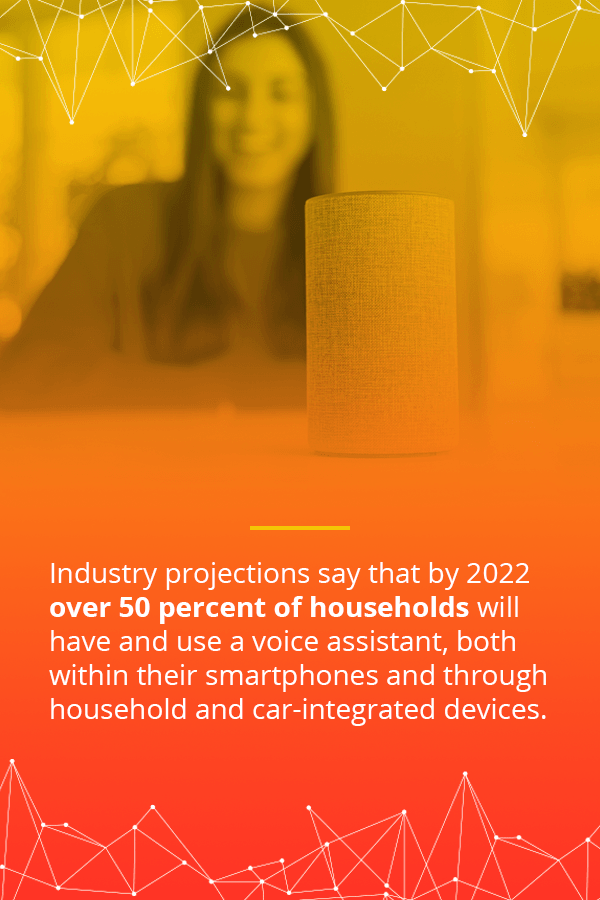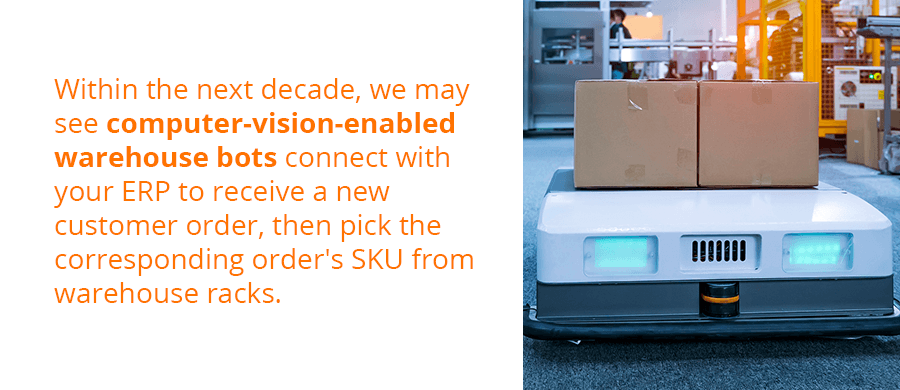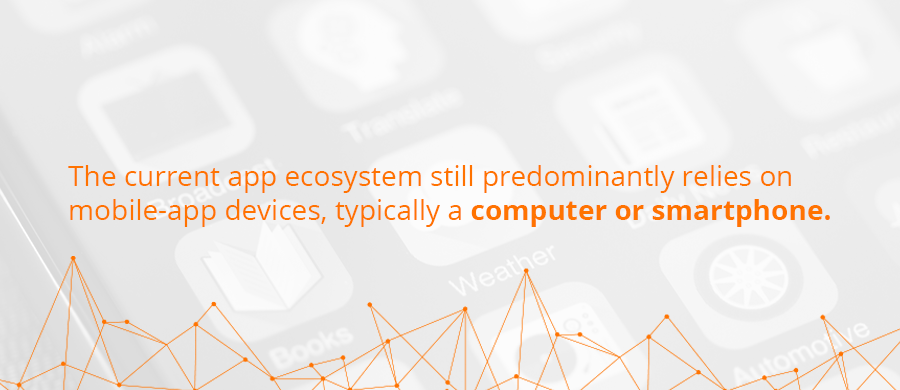Staying in-the-know about tech innovations is essential if you want to stay on top of your industry’s trends. A convergence of factors has IT and infosec professionals abuzz, indicating 2020 is the year several advancements will reach an inflection point and change the ways businesses operate.
In this guide, we’ll discuss the top tech and information security trends of 2020 and which are most relevant to your industry.
Pay Attention to These 11 Technology Trends in 2020
Experts agree: These 2020 tech trends hold the potential to alter the way businesses and consumers interact — internally and with each other:
- 5G and Faster WiFi
- Computer Vision
- Voice Applications
- Safer API-Based Systems
- More Functional Internet-of-Things
- “Flatter” Organizations
- Mobile Payments
- Artificial Intelligence (AI) and Machine Learning (ML) Security
- Mobile Apps
- Blockchain Developments
- The Always Connected PC (ACPC)
1. 5G and Faster WiFi
5G internet has hovered in the public lexicon for a few years. Yet 2020 marks a turning point for the “fifth generation” of wireless technology, with U.S. cellular carriers promising infrastructure with lightning-quick download speeds, more device connections and command latencies in the milliseconds (basically imperceptible to the eye).
The implementation of 5G across the next few years will not be without its hiccups, though. The overwhelming majority of today’s devices cannot connect with 5G’s unique high-frequency radio towers, requiring significant IT hardware and software updates. Plus, only a handful of cities nationwide currently host such 5G towers, serving as beta sites for all major carriers to test their deployments.
In 2020 and beyond, more mainstream 5G will unquestionably trigger additional IT ecosystem developments all organizations must address, including:
- Internet-of-things suited bandwidth: The proliferating amount of interconnected devices — from computers and smartphones to wearables, robots, smart vehicles and more — requires larger and larger bandwidth figures to keep devices communicating properly.
- Updated firewalls: Businesses looking to embrace a 5G network will also need to rework current firewall throughput. Many current firewalls will be unable to support the data speeds and flows unleashed by 5G.
- Stronger edge computing: 5G also improves the business realities of edge computing, namely with its emphasis on local cell towers and local data processing and trafficking to reduce latency.
2. Computer Vision
As its name suggests, computer vision enables machines and equipment to “see” using autonomous cameras. Computer vision cameras are a central piece of technology to many security and operational enterprise advancements, such as the following:
- Business offices and buildings, for enhanced security and around-the-clock “smart building” entry and exit monitoring.
- Manufacturing/production centers, where computer-vision cameras have increased in popularity to spot defective products or components before moving onto next-phase production.
- Warehouses, for enhanced sorting, picking and packing functions, among others.
- Autonomous cars, including freight trucking and last-mile delivery vehicles poised to change supply chain logistics.
The expanding adoption of computer vision cameras comes with an important question, though. Enterprises using these sight-enabled machines and equipment must reconcile the mounting IT ethics behind gathering 24/7 visual data, particularly regarding facial recognition. Organizations must set up transparent computer vision policies, including gathering employees’ and even consumers’ consent about the technology’s usage and highlighting its ethical business case.

3. Voice Applications
Over a third of Americans use voice assistants. Industry projections say that by 2022 over 50 percent of households will have and use a voice assistant, both within their smartphones and through household and car-integrated devices.
This tremendous user uptick will push businesses to prioritize voice applications in several ways:
- Office usage uptick: In 2020 and beyond, employees will start to expect voice assistants at work just as much as they do at home. From adjusting office lighting to booting up technology, scheduling meetings, reading emails and searching the internet to enhanced office surveillance and controlling other connected network devices, worker tasks and activities will become more reliant on voice technology.
- Increased “ask” apps: The rise of voice content means organizations will begin shaping digital content for voice search. Brands like Purina’s “Ask Purina” are ahead of the curve here, creating a voice-exclusive application where dog owners can ask breed-related questions, from ideal diets and exercise routines to in-the-moment health questions, all using a familiar voice assistant.
- Fewer wake words: Currently, popular voice devices require a “wake” word to activate (e.g., “Alexa” in the question, “Alexa, what’s the weather today?”). Wake words let the assistant know you’re talking to it and not, say, yourself. Advancements in voice technology will allow you to speak to assistants more naturally, without the triggering wake word to conduct a search.
- Enhanced voice assistant personalization: Further voice assistant developments in 2020 will allow devices to understand who’s speaking and therefore deliver responses based on individualized voice profiles. Separate voice profiles can, for example, allow assistants to read your correct schedule for the day and not your coworker’s, or save your correct payment or account information.
4. Safer API-Based Systems
APIs, or application programming interfaces, allow different pieces of software to communicate with each other in a safe, standardized way. APIs are central when building proprietary software, evolving into microservice architecture, as well as transferring your enterprise data to vital business or service partners.
Already, we’re seeing an explosion in API integrations across industries, particularly in banking and fintech. Other technologies also require APIs to function. Yet, for the average business, utilizing APIs safely has another important onus: As more employees and customers use more devices with more apps, they’ll simply expect those devices and apps to communicate with one another.
This expectation puts pressure on businesses to ensure their own software programs, products and services integrate seamlessly with others, and that those underlying data connections are safe. Such API security priorities we’ll see in 2020 include:
- API gateway controls, improving traffic authentification, so you know who’s requesting your data, where and for what purpose.
- Tighter API data delegation, helping prevent ominous third-parties from requesting your data, as well as exposing hacks and breach attempts.
- Expansion of open authorization protocols, which allows users (i.e., your employees or your customers) to give permission for their data to be used by other apps and services without handing over their accounts’ passwords.
5. More Functional Internet-of-Things
The internet-of-things buzzword gets tossed around frequently in the business world. In 2020 and beyond, we’ll see its power come into fuller effect — often working without human oversight — to 24/7 connect the burgeoning amount of autonomous and smart devices businesses will use to execute core functions.

Take, for example, delivery logistics. Within the next decade, we may see computer-vision-enabled warehouse bots connect with your ERP to receive a new customer order, then pick the corresponding order’s SKU from warehouse racks. That bot then moves the item to the packaging station, which is wrapped by an autonomous machine. Soon, the order is loaded onto an autonomous vehicle driving it to a local distribution center where drones pick it up and conduct last-mile logistics, dropping it at the customer’s door.
This end-to-end order management is enabled only by the internet-of-things, which harmonizes data and edge devices and lets your business use new equipment to its fullest.
6. “Flatter” Organizations
The past decade’s software advancements allow organizations to practice greater data visibility and oversight than ever. Tools like ERPs, CRMS and other resource planners assist departments, letting employees quickly and conveniently find the information they need to execute their work without bothering employees in other departments for data access.
As technology allows ever greater data and process transparency, we’ll see organizations subsequently turn “flatter.” Defined by reduced informational and managerial hierarchies, flat organizations trim bureaucratic red tape to improve the speed and proactivity of decision-making. Managers will no longer be relegated to constantly approving workloads, task routes and resolutions, since employees are empowered to make these decisions — and those decisions are easily identified and tracked in a horizontal, enterprise-accessible logs.
7. Mobile Payments
In the next decade, businesses must pivot to keep up with the times, embracing prominent payment trends like:
- The accelerated use of mobile wallets (e.g., Apple Pay) over cash and card transactions.
- Voice-recognition transactions, including voice command-led online purchases, as well as voice-based two-factor authentication.
- Mobile fintech portals providing a “one-stop-shop” look into a user’s complete financial portfolio (bank accounts, investments, mobile payment history, etc.).
- Mobile alerts for purchases, account notifications and order updates.
8. Artificial Intelligence (AI) and Machine Learning (ML) Security
Today, most AI and ML cybersecurity programs still reside in the “supervised learning” world. Tomorrow, though, AI and ML will continue its progression into the unsupervised learning space:
- Supervised Learning requires a computer program or piece of software to come with programmed directions, or parameters, guiding how it works and what it can — or can’t — do. In short, supervised programs need to be told how to track and compare new data.
- Unsupervised learning programs, though, do not need pre-programmed data examples or parameters. These applications can identify data patterns on their own, then alert relevant people when manual data reviews or actions need to be performed.
This transition to autonomous data supervision allows business cybersecurity teams to automate an unprecedented amount of network and device security activities. In particular, AI and ML security programs will be better able to:
- Identify new or unauthorized network access and similar security risks.
- Track endpoints and devices better, particularly with the growing number of devices enabled by the internet-of-things, which increases threat vectors.
- Trigger alerts for security updates or maintenance needs.
- Create smarter usage habits, authentications systems and data encryptions bolstering security defenses.
9. Mobile Apps
2020 will also bring major changes and consumer trends affecting mobile applications.

The current app ecosystem still predominantly relies on mobile-app devices, typically a computer or smartphone. However, mobile app developments in the next decade will be influenced by many of the IT advancements on this list — plus a few extra goodies, including:
- Growth of the instant app: Many smartphone owners know the frustration of managing low storage space on their mobile devices or using apps that take up too much room even on unencumbered phones, tablets and wearables. Instant apps offer an alternative, letting users access a smaller version of an app without actually installing it on their devices. Instant apps have grown in popularity in the past few years, with many thought leaders predicting a new, widening rollout of app brands and developers producing instant versions of their most popular applications in 2020 and beyond.
- Voice-enabled personalization: Many business apps will adapt to match the growing popularity of voice search. In some cases, organizations may even deploy voice-specific applications to answer user queries or provide specific services. Organizations may also begin implementing voice-controlled security and authentication for in-office devices and programs alongside these voice deliverables for consumers.
- 5G connection capabilities: 5G’s quicker data delivery and almost non-existent latency means apps won’t have to work as hard to perform core functions. This preserves your mobile device’s battery life and extends the usability of your apps, plus also introduces a mobile platform finally functional for in-depth augmented reality (AR) and virtual reality (VR) apps that congested all previous networks.
10. Blockchain Developments
Blockchain had its biggest year yet in 2019. Major companies — from IBM to Walmart, FedEx to Facebook and more — committed to blockchain developments for various pilot — and often proprietary — programs, adding legitimacy to the decentralized ledger technology. Many hope to use blockchain beyond its transaction recording and management origins, though, expanding it for dual security and service-related offerings:
- Internal blockchain business advantages: Internally, blockchain offers improved tracking for physical and non-physical enterprise assets. Blockchain ledgers can be used across the supply chain to identify production problems or proper recall points for goods, to bolster vendor compliance, trigger proof-of-delivery transactions or track system or network log-ins.
- External blockchain business advantages: Outside your business’ walls, blockchain technology can help manage more secure vendor payments, contracts and business partnerships by triggering payment or settlement transactions after the ledger notes a complaint or sees goods have been delivered. Blockchain data ledgers are also more secure and transparent, given their decentralized setup and encrypted framework that cannot be altered.
IT trends in 2020 will likely embrace blockchain as a transaction-tracking and management system for goods and services across its clients, suppliers and vendors. Many will need to create ledgers addressing the tool’s top pain point, though: interoperability. Currently, blockchain-designed programs are unable to share its information with anything outside itself (a.k.a. other transaction-management systems or even other blockchain ledgers), preventing the tool from reaching its full potential.
11. The Always Connected PC (ACPC)
Always Connected PCs are the next generation of computers as we know them. Boasting the same processing technology as today’s top smartphones, but placed inside a laptop or computer’s hardware, the ACPC presents a range of capabilities no other device does, including:
- 24/7/365 web access: As their name suggests, an ACPC should always have access to the web via both LTE and WiFi connections, even when you close up the computer. Most recently, a Lenovo-Qualcomm partnership announced its plan to produce 5G-connected ACPCs for 2020.
- Qualcomm processor chips: A smartphone-mirroring microprocessor allowing integration with a Windows 10 operating system.
- Extensive battery life: In some units, developers claim 20+ hours without the need to charge.
- Ultra-lightweight: Allowing laptops to be portable and user-friendly without sacrificing functionality.
Early models of the Always Connected PC were not without their flaws, though. Many users experienced issues loading and running a handful of 64-bit apps on their laptops, including some popular Microsoft Office programs. Next-phase ACPC models produced in 2020 and beyond will prioritize these bit-version incompatibility snafus, with producers like Lenovo stating their commitment to providing a fully synchronized, true-to-its name breed of computer.
Stay on Top of Technology Trends With PCS
It’s exhausting keeping tabs on tech business trends for the next 10 years — and beyond. That’s where PCS comes in.
We work with clients to untangle IT. From IT project support to a dedicated, fully managed IT team taking care of the bulk of your IT operations, let us handle your business’ tech side — so you have one less thing to worry about.
See what IT work we can take off your shoulders, then request a personalized quote.

